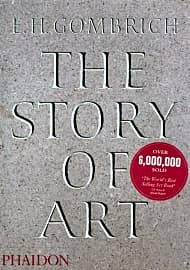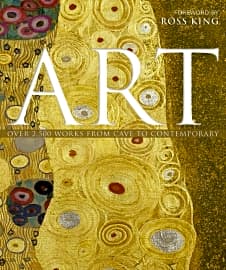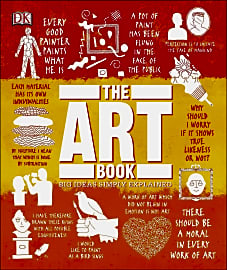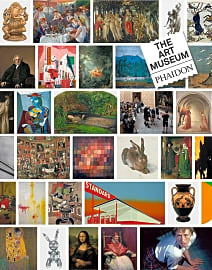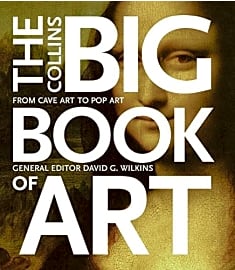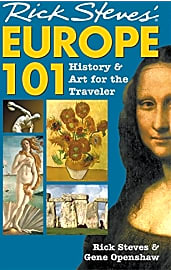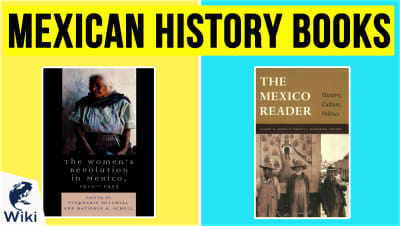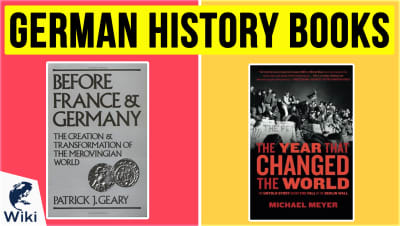The 10 Best Art History Books

This wiki has been updated 37 times since it was first published in August of 2015. Including editions that would make thoughtful gifts for any student or aficionado, our selection of art history books has something for everyone, from the academic to the casual museum-goer. Each provides a look at art throughout the ages, and can help foster a greater appreciation of the world’s most celebrated pieces. And, of course, they offer plenty of gorgeous prints to enjoy. When users buy our independently chosen editorial choices, we may earn commissions to help fund the Wiki.
Editor's Notes
July 13, 2020:
For this latest update, we continued to prioritize reader-friendly, introductory works without getting mired in niche or overly scholarly volumes. If you're looking for tomes that are more academically rigorous, our list of art history textbooks is worth a look.
Today we decided to say goodbye to Endless Enigma: Eight Centuries of Fantastic Art, although we still feel it's an intriguing choice worthy of perusal for those interested in some of the more unsettling and surreal works that have been produced. Because it's a compendium of pieces that isn't terribly explanatory, we felt it didn't do enough to teach the reader about the history behind the work it features. We also removed Art: A World History, which itself is a very good reference guide for those already well-versed in the subject. But because it's a pocket-sized book, the reproductions are small and hard to appreciate, which is not ideal when you're trying to learn about them.
To fill the void we brought on The Brilliant History of Color in Art, an extremely beginner-friendly selection that is perfect for lovers of trivia, as it's jam-packed with fascinating anecdotes relating to color, artists, and works of art throughout the centuries. Even readers who have never read a line about art history should find much to enjoy about it, but it's far from comprehensive, so those looking for extremely in-depth information about color use might want to take note.
We also added Women in Art, another easily accessible book that introduces readers to artists they may already know, like Frida Kahlo, and lesser-known ones, like the 19th-century quilter Harriet Powers. This one is warm and engaging, lavishly illustrated, and comprehensive for teens as well as interesting to many adults.
June 07, 2019:
Choosing the "perfect" or "best" art history book is a nearly impossible task; the available subject matter and the ways of tackling it are virtually endless, and whether someone enjoys a book is really down to a reader's personal tastes. Compounding this difficulty is the fact that there are myriad styles and types of art from all across the globe, which means that some traditions are bound to be left out in each book. We've looked for reader-friendly works that attempt to give a broad introduction and therefore mean no slight to those artists or traditions that are represented to a lesser degree.
With that said, we still feel that it's appropriate to call The Story of Art and Gardner's Art through the Ages top choices. Although they perhaps don't have the accessibility a casual reader is looking for, they tackle the subject matter in a way that is meaningful and informative, helping to build a foundation upon which further study can be built. Those who want a book they can dip in and out of might instead enjoy Art: Over 2,500 Works from Cave to Contemporary or 50 Artists You Should Know. The latter has been criticized, however, as it features 49 male artists and only one female, which is not a very compelling ratio. And, speaking of criticism, Rick Steves’ Europe 101: History and Art for the Traveler has also been taken to task for being biased politically. It is, however, an excellent resource for anyone who wants to appreciate art on their European travels, so we feel it is still worth including.
Special Honors
Khan Academy Art History If you're looking to supplement your reading with an online class, Khan Academy offers an introductory course on the subject. The material touches on everything from prehistoric depictions to contemporary abstraction and covers work from around the globe. You'll learn about African, European, Islamic, American, Asian, and Oceanic art via short videos, articles, and quizzes. khanacademy.org
Art Authority Compatible with Apple devices, Art Authority connects users to a digital museum filled with pieces by over 1,500 of the Western world's greatest artists from ancient times to today. There are 100,000 paintings and sculptures organized into eight period-specific rooms. You can choose an artist by movement or name, or search for and compare different works by title, subject, or location. There are also period overviews, timelines, and histories, links that provide access to in-depth information on artists, major works and locations, and videos on hundreds of works. artauthority.net
A Brief History Of Art History
Vasari's work was a hot topic of discussion for centuries in Europe, though it was not without its critics.
Some of the first known art historical writing was by a Roman author called Pliny the Elder, who lived in the 1st century C.E. Pliny wrote primarily about science, though he also catalogued the development of Greek painting and sculpture in his multi-volume encyclopedic work "Natural History," first published in the year 77.
Following Pliny, the next notable work in the art history canon didn't arrive until nearly 500 years later, in the form of the book "The Record of the Classification of Old Painters" by Chinese author Xie He, circa 550. In it, he highlighted the work and style of writers whose calligraphy was art unto itself, and also enumerated the Six Principles of Painting. In doing so, he composed what is considered the first published work dealing with the methodology of studying art, as opposed to just recording the lives and works of artists themselves.
The first text to attempt to record the history of art as a whole is "The Lives of the Most Excellent Painters, Sculptors, and Architects," which Giorgio Vasari, an Italian painter and architect himself, composed in 1550. While it primarily focused on artists' biographies, it is widely considered the seminal text for the history of Renaissance-era art.
Vasari's work was a hot topic of discussion for centuries in Europe, though it was not without its critics. A school of thought led by German historian and archaeologist Johann Joachim Winckelmann arose in the mid-18th century that felt Vasari's approach was far too focused on the artists themselves, with not enough attention paid to their art. Winckelmann is considered an early father of art criticism thanks to his approach, outlined in his books "History of Ancient Art" and "Reflections on the Painting and Sculpture of the Greeks," circa 1764 and 1765, respectively. The former boasts the first recorded appearance of the phrase "art history" in print.
Throughout the 18th and 19th centuries, various European scholars and historians expanded upon Winckelmann's approach, melding criticism and analysis with history in their assessments of artistic movements past and present. This approach was formalized by another German, the scholar and professor Heinrich Wölfflin, in three books published during the late 19th and early 20th centuries. Wölfflin is widely known as the father of art history for his contributions, which elevated the study of art to a highly respected discipline worldwide.
A major development in art history came in the wake of World War II, when photographic technology began allowing for much more widespread reproduction of images of famous artworks. The improvement and availability of reproduction technology helped spread the study of art beyond elite institutions and cement art history's place in curriculums everywhere, for scholars of all ages.
Varying Approaches to the Study of Art
To this day, there are many varying schools of thought of how best to approach this study of art and its history. The most formal and scientific of these approaches belongs to Heinrich Wölfflin, who prescribed a detailed, methodical approach to understanding any given work of art in the context of its creation. His methodology focused on three principles or approaches; psychology, comparison, and nationhood.
In Barthes' view, any work of art can be assessed by the signifiers it contains and their inherent references.
While Wölfflin's method included the study of the psychology of the artist, the father of psychoanalysis, Sigmund Freud, took things a step further in his approach to art history. Freud used an artist's works to conduct a reverse-analysis of the artist's psyche, analyzing a variety of symbolic and stylistic motifs to determine hidden biographical information about them. The most notable work of his in this vein is a book about Leonardo da Vinci, who Freud guessed was a homosexual based on his paintings. Though controversial, the psychoanalytic approach to art history remains popular today.
The French literary theorist Roland Barthes wrote extensively about semiotics, or the study of signs, including about how the study of art can be enhanced by employing its ways of thinking. In Barthes' view, any work of art can be assessed by the signifiers it contains and their inherent references. He also wrote about separating the interpretation of works of art from the identities of their creators, most notably in 1968's "The Death of the Author."
Even this small sampling of ways of thinking about art contains many opposing viewpoints, as well as some that may complement or build on one another. In truth, there is no right way to interpret art or study its history. The best art historians and historical texts will draw on the ideas and methodologies of a wide range of thinkers in order to offer balanced perspectives and useful interpretations.
The Importance Of Learning About Art
Whether you're a reluctant student or just a curious scholar, it's important to remember that there are plenty of good reasons to study art history. For starters, learning about art helps you learn about the world. By developing the vocabulary to analyze art, you learn how to speak about the visual world in general, a skill that will come in handy in situations as diverse as deciding what color to paint a house to describing a meeting place to a friend.
Reflecting on what's come before you will never steer you wrong when you're trying to make a decision or come up with a solution to any one of life's myriad problems.
Studying art also helps you think more creatively. By looking at the history of artistic expression and perspective from ancient times up to the present, you're inherently learning new ways to express yourself, whether visually or simply in your speech or thoughts. Reflecting on what's come before you will never steer you wrong when you're trying to make a decision or come up with a solution to any one of life's myriad problems.
Not only is the study of art a way to build one's own visual vocabulary and think outside the box, but it can also help improve your understanding of history in general. So much art has been made about politics, revolution, war, and historical figures. If reading a history textbook doesn't sound like your ideal method of learning about the past, consider looking at art from the period instead. There's always more to learn.



